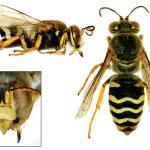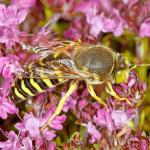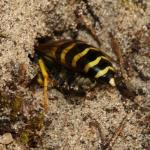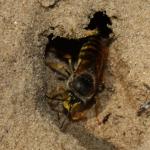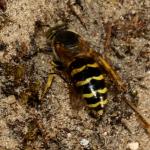A large, black and yellow, ground nesting solitary wasp. A key can be found in Lomholdt (1984). (Richards (1980) mentions the genus in his introduction but does not provide a key to the species.)
Only recorded from the Channel Islands. Overseas found widely distributed throughout Central and Southern Europe through to Central Asia and Mongolia.
Found in a range of open habitats with light soils such as heathland and coastal dunes.
Nest burrows are stocked with a range of Diptera: Brachycera from various families. Nesting biology Nests are dug in sandy soil in level areas exposed to full sun, with nesting often occurring in large aggregations. Nests consist of a single sloping unbranched burrow of 10-15cm in length with a single cell at the bottom, the last part of which may be dug nearly horizontally (Lomholdt 1984). Bembix practices progressive provisioning, females initially stock the nest with a small fly onto which the egg is laid and seal up the entrance. As the larva grows and consumes its meal, larger prey items are brought to the nest, with the female sealing the burrow after each visit. Females may be provisioning a number of nests at the same time. When fully fed the larvae spin tough cocoons incorporating sand grains into the outer wall, which are said to be "strong enough to withstand the maximum pressure between human fingers" (Crompton 1948).
No information available.
None recorded from Britain. In Fennoscandia, Lomholdt cites the non-British chrysid wasp Parnopes grandior as a parasite, together with Sarcophagid flies. Bembix is also used as a host by some species of Conopid flies.


